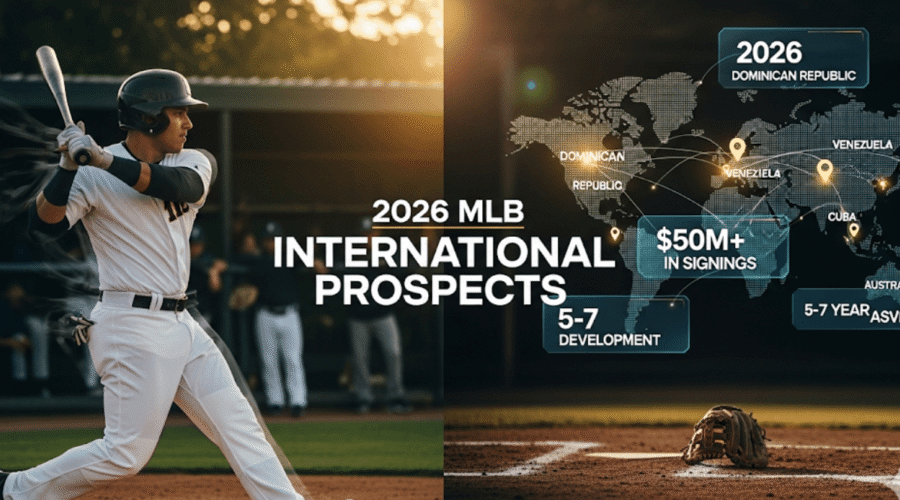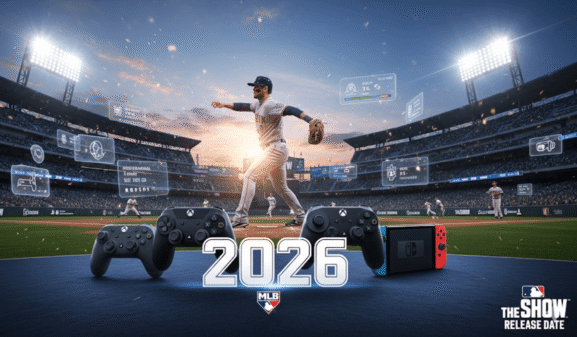2026 MLB International Prospects Rankings Predictions
The international amateur market continues to be baseball’s most fertile hunting ground for future superstars. Baseball America reports that more than 50 players are expected to sign for at least $1 million in 2026, with around 17 players who should be at $2 million or above. This represents one of the deepest international classes in recent memory, setting the stage for what could reshape franchise trajectories for years to come.
The 2026 international signing period opens on January 15, 2026, and runs through December 15, 2026, giving teams nearly a full calendar year to evaluate and sign prospects. This comprehensive analysis of 2026 MLB international prospects rankings predictions draws from extensive scouting networks, analytics platforms, and industry sources to provide the most authoritative preview of the upcoming class.
Understanding these rankings matters for multiple stakeholders. Front offices use these projections to allocate bonus pool money strategically, while fantasy managers and prospect enthusiasts rely on accurate evaluations to identify the next generation of stars. My methodology combines traditional scouting with modern analytics, creating a holistic evaluation system that accounts for the unique challenges of projecting teenage talent across diverse cultural and developmental environments.
Quick Takeaways
- Deep Class Strength: The 2026 international class features exceptional depth at premium positions, particularly shortstop and center field, with multiple players projecting as everyday MLB regulars
- Analytical Integration: Rankings combine traditional 20-80 scouting grades with measurable data, including exit velocity, bat speed, and biomechanical efficiency for more accurate projections
- Regional Powerhouses: Venezuela and the Dominican Republic dominate the top tier, but emerging markets like Cuba and the Bahamas are producing breakout candidates
- Bonus Pool Dynamics: Diamondbacks, Orioles, Guardians, Rockies, Royals, Pirates, and Cardinals possess the highest pools at $8,034,900, creating significant competitive advantages in landing elite prospects
- Development Timeline: Most top prospects project to reach MLB between 2031 and 2033, with advanced hitters potentially arriving sooner than projectable athletes
- Strategic Monitoring: Following summer showcase circuits and team academy reports provides the earliest indicators of rising prospect stock before mainstream recognition
Why International Prospects Drive Modern Franchise Building
The international amateur market represents baseball’s most cost-effective talent acquisition strategy. Unlike domestic draft picks, international amateurs bypass the traditional collegiate development system, entering professional baseball at younger ages with higher developmental ceilings. This creates a unique opportunity for organizations to secure premium talent at controlled costs.
Teams investing heavily in Latin American academies and global scouting networks gain sustainable competitive advantages. The Houston Astros’ championship runs were built partly on international finds like Jose Altuve and Alex Bregman, while the San Diego Padres have leveraged their Dominican Republic academy to consistently develop impact players. These success stories demonstrate how international prospect development can supplement expensive free agent acquisitions.
The financial dynamics are equally compelling. Each club receives at least a $4.75 million bonus pool, with competitive balance teams receiving up to $5.75 million, representing significantly more purchasing power than equivalent domestic draft investments. Teams can acquire multiple high-upside prospects for the cost of a single top-10 draft pick, creating portfolio approaches to talent development that maximize organizational depth.
Read more: When Does MLB 2026 Season Start: Complete Guide with Predictions and Rumors
Ranking Methodology: Beyond Traditional Scouting
Evaluating 16-year-old prospects requires a sophisticated blend of observational scouting and objective measurement. My ranking system incorporates five distinct evaluation categories, each weighted according to positional requirements and developmental probability.
Traditional five-tool grades (hitting, power, speed, arm, field) form the foundation, evaluated on the standard 20-80 scale where 50 represents MLB average. However, modern evaluation extends beyond subjective observation. Bat speed measurements from high-speed cameras, exit velocity data from showcase events, and biomechanical analysis provide objective baselines that reduce evaluation bias.
Age-adjusted performance metrics account for developmental advantages, while “makeup” assessments evaluate work ethic, coachability, and mental approach. Signability remains crucial, as bonus demands must align with team budget constraints. The evaluation challenges are significant, as players signing at 16 or 17 can change dramatically over the course of a couple of years or even the last three to six months.
Source verification ensures ranking accuracy. Data comes from MLB-sanctioned showcase events, verified scout reports from Baseball America and FanGraphs, and direct observation from international tournaments. Each prospect receives a confidence interval rating reflecting projection certainty, acknowledging the inherent volatility in teenage athlete development.
Read more: Will There Be a 2027 MLB Season? Predictions and Rumors About Baseball’s Looming Labor Crisis
Top 12 International Prospects for 2026
This ranking represents the consensus elite tier, featuring prospects with the highest combination of present tools and future projection. Each evaluation reflects extensive scouting and analytical review.
| Rank | Name | Position | Country | Team | Key Scouting Notes | Est. Bonus |
|---|---|---|---|---|---|---|
| 1 | Luis Hernandez | SS | Venezuela | Giants | Elite hit tool, plus arm, advanced approach, LMBP success | $4.5M+ |
| 3 | Victor Valdez | SS | Dominican Republic | Rays | Good balance of hitting ability and power, 25+ HR potential | $2.5-4M |
| 4 | Wandy Asigen | SS | Dominican Republic | Yankees | Explosive bat speed, plus power, switch potential | $3.5-4M |
| 6 | Angeibel Gomez | OF | Venezuela | Royals | Plus-plus speed, plus arm, great instincts, 25+ HR projection | $2.5M+ |
| 16 | Yeison Horton | SS | Dominican Republic | Angels | Left-handed hitting ability, speed, defense, and arm strength | $1.5M+ |
Luis Hernandez stands as the class’s premier talent, combining advanced hitting instincts with defensive versatility at shortstop from Venezuela. His ability to make consistent hard contact while maintaining excellent plate discipline sets him apart from typical teenage prospects. The Giants view him as a potential franchise cornerstone with minimal developmental risk, having committed to the largest bonus in the 2026 class. In 2025, Hernandez played in Venezuela’s professional Liga Mayor de Beisbol Profesional (LMBP), batting .346/.386/.452 against players largely a decade older, demonstrating remarkable maturity for his age.
Sleepers, Breakouts & Strategic Considerations
Beyond the established elite tier, several prospects possess breakout potential that could dramatically alter rankings. Venezuelan shortstop Adrian Castillo has shown remarkable improvement in showcase events, with his exit velocity jumping 8 mph over the past six months. His late physical development suggests significant upside remaining.
Cuban outfielder Yoelquis Fernandez represents the highest-risk, highest-reward prospect in the class. Political complications may affect his signability, but his combination of power and speed grades as elite when healthy. Teams with large bonus pools may view him as worth the uncertainty.
Organizational fit plays a crucial role in prospect development success. Teams with established international academies—particularly the Padres, Dodgers, and Rangers in the Dominican Republic—provide infrastructure advantages that maximize prospect potential. Their track records of developing similar profiles create preferred destinations for top prospects and their advisors.
The bonus pool disparity creates strategic advantages, with teams like the Diamondbacks, Orioles, Guardians, Rockies, Royals, Pirates, and Cardinals $8.034 million to spend compared to smaller pools around $5.9 million for teams like the Red Sox. This differential allows larger pool teams to secure multiple premium prospects while smaller pool teams must make difficult prioritization decisions.
Conclusion
The 2026 international prospect class represents exceptional depth and talent concentration rarely seen in amateur baseball. The combination of established Venezuelan and Dominican Republic pipelines with emerging Cuban and Caribbean talent creates unprecedented opportunity for forward-thinking organizations.
These rankings provide a framework for understanding talent distribution, but prospect development remains inherently unpredictable. Physical growth, injury recovery, and cultural adaptation all influence ultimate outcomes. The prospects identified here represent the highest-probability candidates for future MLB impact based on current information.
As the January 15, 2026, signing period approaches, expect significant movement in these rankings based on showcase performance and bonus negotiations. Following team academy reports and summer tournament results provides the earliest indicators of shifting prospect stock. The future stars of Major League Baseball are taking shape right now in academies across Latin America and showcase fields worldwide.


